Your retail lighting feels flat, and products aren't getting noticed. This lack of visual appeal could be costing you sales. The right COB downlights can make your merchandise pop.
The best COB LED downlights for retail and showrooms feature a high CRI of 90+, an appropriate beam angle for your space, and a robust thermal management system. These elements ensure true-to-life colors and a long, reliable lifespan for the fixture, which is essential for commercial environments.
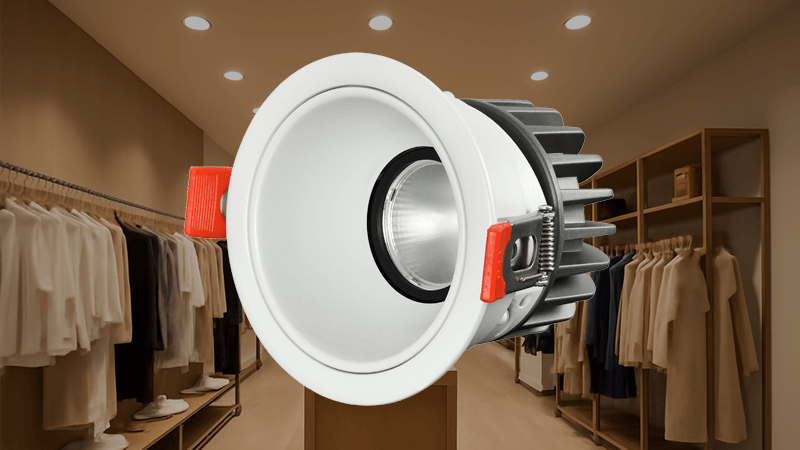
Choosing the right lighting can feel like a huge challenge. There are so many technical terms and options. But getting it right is the difference between a forgettable space and one that captivates customers and drives sales. I’ve spent my career in LED manufacturing, and I'm here to break down exactly what you need to know. Let's walk through the key questions to find the perfect lighting solution for your business.
Are COB LEDs Worth It?
Confused by all the lighting acronyms and technologies? You worry about investing in the wrong type of LED and making a costly mistake. Let’s clarify if COB is right for you.
Yes, COB LEDs are absolutely worth it for retail and showrooms. They provide a powerful, high-quality, single-point light source1 that mimics a halogen lamp. This creates excellent color rendering2 and crisp shadows, making products look their best. Their efficiency and long lifespan offer great value.
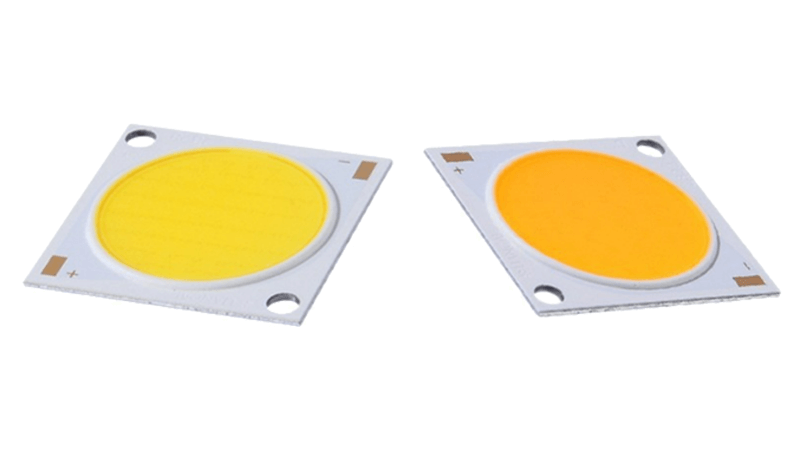
When I first started in this industry, SMD (Surface Mount Device) LEDs were everywhere. They are great for many applications, but they have a drawback in spotlighting: they create multiple, soft shadows because they consist of many small light points. This can make products look a little blurry or flat. Then came COB (Chip on Board) technology. COB packs many tiny LED diodes together on a single board, so they function as one powerful light source. Think of it as a single, intense beam of light.
This single-point source is why COB is a game-changer for retail. I remember working with Shaz, a purchasing manager from the UAE with over a decade of experience. He was skeptical about switching his company's showrooms to COB. We sent him some samples to test. The moment he turned them on, he saw the difference. The single, clean shadow and vibrant colors made his merchandise stand out dramatically. His decision was made on the spot.
Here’s a simple breakdown of why COB often comes out on top for these applications:
Key Advantages of COB Technology
- Superior Light Quality: The concentrated light source delivers a focused beam with high intensity. This creates the contrast needed to draw a customer's eye to specific products.
- No Multi-Shadow Effect: Unlike SMD arrays, COB produces a single, crisp shadow. This makes products look cleaner and more defined, which is crucial for luxury goods, apparel, and cars.
- Higher Luminous Efficacy: COB LEDs can produce more lumens per watt. This means you get more light for less energy, which lowers your electricity bills.
- Better Thermal Management: The single ceramic substrate used in COB LEDs allows heat to dissipate more efficiently than from multiple individual SMD chips. Better heat management directly translates to a longer, more reliable lifespan for the light.
Here's a quick comparison:
| Feature | COB (Chip on Board) | SMD (Surface Mount Device) |
|---|---|---|
| Light Source | Single, concentrated point | Multiple, spread-out points |
| Shadows | Single, crisp shadow | Multiple, soft shadows |
| Best For | Accent lighting, high ceilings, showrooms | General lighting, backlighting, linear lights |
| Heat Dissipation | Excellent | Good |
| Visual Effect | Dramatic, high contrast | Diffuse, even illumination |
For any business that relies on visual appeal, the investment in COB technology pays for itself through better product presentation3 and energy savings4.
How Do You Choose the Right COB Light?
You know you want COB lights, but the market is flooded with options. Sifting through technical specifications is overwhelming, and you fear making a choice you'll later regret.
To choose the right COB light, focus on four key specs: a CRI above 90, the correct CCT for your brand's atmosphere, a suitable beam angle5 for your layout, and adequate lumens. Also, always inspect the heatsink and driver quality.
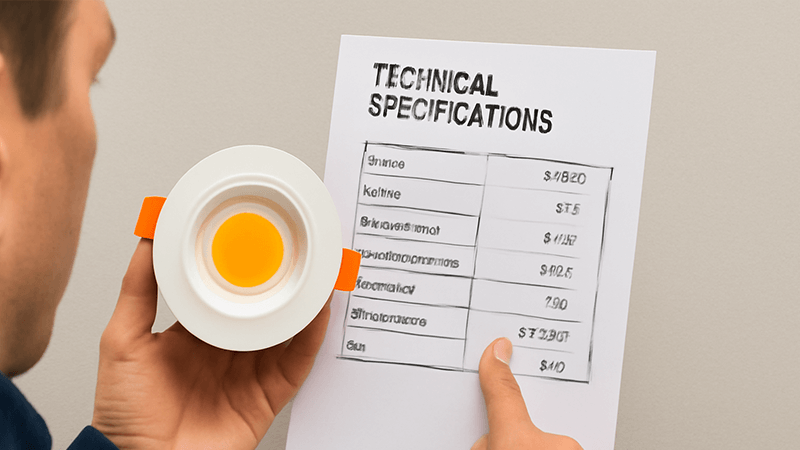
Over the years, I've helped countless clients like Shaz navigate these choices. It’s not about finding the light with the biggest numbers; it’s about finding the one with the right numbers for your specific needs. If you ignore these details, you could end up with lights that make your products look cheap, fail prematurely, or create an uninviting atmosphere. Let's break down what truly matters.
Your COB Downlight Selection Checklist
You should treat these factors as non-negotiable for a professional retail or showroom environment.
- Color Rendering Index (CRI): This measures how accurately a light source reveals the true colors of an object. For retail, a CRI of 90 or higher is essential. Anything less (like a standard CRI 80) can make colors look dull or shifted. Imagine a customer trying on a red dress that looks washed out or orange under poor lighting. That’s a lost sale.
- Correlated Color Temperature (CCT)6: This is the color of the light itself, measured in Kelvin (K). It sets the mood of your space.
- 2700K-3000K (Warm White): Creates a cozy, inviting atmosphere. Perfect for boutiques, jewelry stores, and high-end restaurants.
- 4000K (Neutral White): A clean, modern, and professional look. Great for fashion, electronics, and car showrooms where clarity is key.
- 5000K+ (Cool White): A very bright, stimulating light that mimics daylight. Best used in task-heavy areas or for a hyper-modern aesthetic.
- Beam Angle: This determines the spread of the light.
- Narrow (10°-24°): Use for accent lighting. Perfect for highlighting a single mannequin, a piece of art, or a jewelry display.
- Medium (25°-40°): A versatile option for general highlighting of product displays or sections within a store.
- Wide (41°+): Used for general ambient illumination to light up walkways and open areas.
- Lens and Reflector Quality: This is a detail many people miss, but it's critical. The lens or reflector focuses the light from the COB chip. I always insist that my clients choose a fixture where the lens transmittance7 is 90% or higher. A low-quality lens can reduce light output by 15-20%, which means you're wasting energy and not getting the brightness you paid for. You have a powerful engine (the chip), but the light gets stuck in traffic (the lens).
| Specification | What to Look For | Why It Matters for Retail |
|---|---|---|
| CRI | 90+ | Shows true product colors, increases sales appeal. |
| CCT | 3000K, 4000K, or 5000K | Matches your brand's atmosphere and mood. |
| Beam Angle | 10°-60° | Creates either focused drama or general light. |
| Lens Transmittance | ≥90% | Ensures maximum light output and system efficiency. |
| Heatsink/Driver | Quality materials, good brand | Guarantees long life and reliable performance. |
By focusing on these elements, you can confidently select a COB downlight that will perform flawlessly and make your space shine.
Is There Anything Better Than COB LED?
You've just gotten comfortable with COB, but technology never stops. Are you investing in something that’s already on its way out? Let's see what else is out there.
While COB is a top choice, technologies like CSP (Chip Scale Package) and advanced SMD modules are strong alternatives. The "better" technology depends entirely on the application, whether you prioritize compactness, cost-effectiveness, or a specific light distribution pattern.
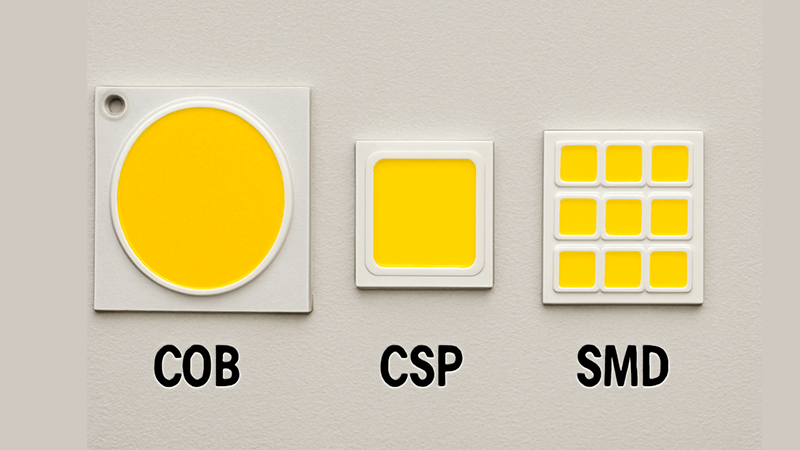
In the lighting industry, "better" is a relative term. It's like asking if a sports car is better than a truck. One is built for speed, the other for hauling. The best choice depends on the job. COB technology excels at creating a powerful, punchy, single-point light source1—perfect for the drama of retail. However, other technologies have their own strengths.
As a manufacturer, I'm constantly evaluating new components to provide the best solutions. Shaz, my client from the UAE, once asked me this exact question for a new luxury car showroom project. He wanted the absolute best lighting to make the cars' metallic paint and chrome details sparkle. We looked at the main alternatives together.
Exploring the Alternatives
-
CSP (Chip Scale Package): This is the next step in miniaturization. CSP LEDs are essentially raw LED chips with no extra packaging, making them incredibly small.
- Pros: Their tiny size allows for very compact and flexible fixture designs. They can be packed together even more densely than COB for extremely high-intensity light.
- Cons: Because they are so small and powerful, managing their heat is a significant engineering challenge. They can also be more expensive.
- Verdict: Great for specialty applications where space is extremely limited or unique beam shapes are needed, but for a standard downlight, COB often provides a more reliable and cost-effective balance of performance and thermal management.
-
Advanced SMD (Surface Mount Device) Modules: Don't count SMDs out just yet. Technology has improved.
- Pros: Modern high-power SMDs are very efficient and can be arranged on a board in any pattern. This makes them ideal for creating very uniform, diffuse light for panels and linear fixtures. They can also be a more cost-effective solution for general ambient lighting.
- Cons: They still suffer from the multi-shadow effect when used for spotlighting, which is generally undesirable for highlighting products.
| Technology | Best Use Case | Key Strength | Key Weakness |
|---|---|---|---|
| COB | Retail & Showroom Spotlighting | High-intensity, single-point source | Less flexible for wide, diffuse light |
| CSP | Compact & Custom Fixtures | Extreme miniaturization, design freedom | Heat management can be difficult |
| Advanced SMD | General Ambient & Linear Lighting | Cost-effective, uniform light spread | Creates multiple shadows in spotlights |
For the car showroom, Shaz and I concluded that COB was still the undisputed champion. The crisp, single shadow it created under each car defined its shape and made it look powerful and sleek. The alternatives couldn't replicate that specific punchy, high-contrast effect. So, while other technologies exist, for creating focal points in retail, COB remains one of the best tools for the job.
How Do I Choose a Good LED Light in General?
Choosing any type of LED, not just COB, feels complicated. You hear horror stories about flickering lights, bad colors, and fixtures that die just after the warranty expires.
To choose any good LED light, look past the basic specs. Verify its certifications (like CE, RoHS), check the warranty period (3-5 years is a good sign), and assess the quality of its core components: the chip, driver, and heatsink.
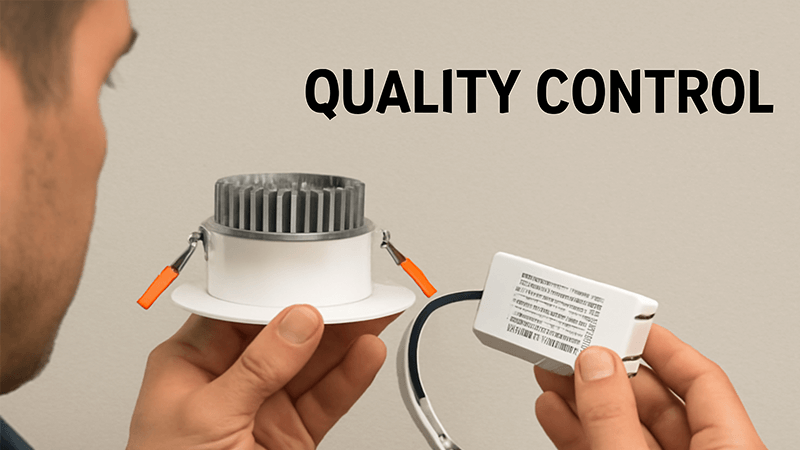
A spec sheet can be misleading. Any factory can claim high lumens or a long lifespan. The real proof of quality is in the parts you can't easily see and the promises the manufacturer is willing to stand behind. I built my business, Upward Lighting, on the principle of delivering quality you can see—and quality that lasts. This means focusing on the fundamentals.
When you're sourcing lighting, whether you're a purchasing manager like Shaz or a project contractor, you need to think like an engineer for a moment. A great LED fixture is a system where every part works together. A failure in one part brings the whole system down.
The Ultimate Quality Checklist
Here is a simple checklist I use to evaluate any LED product.
-
Certifications and Warranty:
- Certifications (CE, RoHS, UL, etc.): These aren't just logos. They mean the product has been tested to meet critical safety, environmental, and performance standards. Never buy an uncertified product for a commercial project.
- Warranty: A short 1 or 2-year warranty suggests the manufacturer doesn't expect the product to last. Look for a 3 to 5-year warranty. This is a direct reflection of their confidence in their components and engineering.
-
The Three Pillars of Quality:
- 1. The LED Chip: Ask for the brand of the chip. Reputable brands like Cree, Bridgelux, Citizen, and Lumileds have a track record of consistent performance and longevity. A no-name chip is a huge red flag.
- 2. The Driver: The driver is the power supply for the LED. It's the most common point of failure. A cheap driver will cause flickering, have poor efficiency, and fail early. Ask for trusted driver brands like Mean Well, Philips, or Tridonic. A stable, flicker-free driver is non-negotiable.
- 3. The Heatsink: Heat is the number one enemy of LEDs. A heatsink's job is to pull heat away from the chip. A poorly designed heatsink—made from thin aluminum or with too few fins—will cause the chip to overheat and fail prematurely. A good heatsink feels solid, heavy, and has a large surface area for heat dissipation.
| Quality Check | What to Look For | Why It’s Crucial |
|---|---|---|
| Warranty | 3-5 years | Shows manufacturer's confidence in product life. |
| Certifications | CE, RoHS, UL | Confirms safety and performance standards are met. |
| LED Chip | Reputable Brands (Cree, Bridgelux, etc.) | Ensures consistent light quality and longevity. |
| Driver | Reputable Brands (Mean Well, Philips, etc.) | Prevents flicker and is the key to reliability. |
| Heatsink | Solid aluminum, large surface area | Protects the LED chip from heat damage. |
When you partner with a supplier, you are trusting them with your project's success. Choose a manufacturer who is transparent about their components and who sees you as a partner, not just a transaction. That is the ultimate sign of a good LED light.
Conclusion
Choosing the best COB downlights boils down to focusing on a high CRI, the right beam angle, and quality components. This ensures your retail space will attract customers and showcase products perfectly.
Discover how single-point light sources improve lighting quality and product visibility in retail. ↩
Find out how color rendering impacts the appearance of products and customer perception. ↩
Understand the impact of lighting on product presentation and customer buying decisions. ↩
Explore how LED lighting can significantly reduce energy costs in retail and commercial spaces. ↩
Discover the significance of beam angle in creating effective lighting layouts for retail. ↩
Understand how CCT influences the mood and atmosphere of retail spaces. ↩
Learn about lens transmittance and its role in maximizing light output and efficiency. ↩

